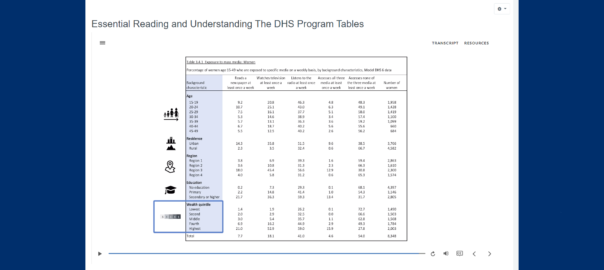New Online Course: Essential Reading and Understanding The DHS Program Tables

The DHS Program’s Final Reports include comprehensive survey results. The most important findings are highlighted in the chapter text and figures, though not every finding is discussed or displayed graphically. Therefore, it is important for DHS data users to feel comfortable reading and interpreting the statistical tables included in every Final Report, which can look intimidating at first.
To help DHS data users confidently read and interpret tables, The DHS Program has a new open course available for free with a simple registration on the Learning Hub. Essential Reading and Understanding The DHS Program Tables is a course for anyone interested in understanding demographic and health data found in Final Reports. This interactive course familiarizes users with the basic elements of DHS Program tables.
In the Essential Reading and Understanding The DHS Program Tables course, participants will learn:
- The 4 basic steps in reading The DHS Program tables
- To identify the denominator of the table, the indicators and background characteristics presented, and the totals in the table
- How to compare indicator data by background characteristics and identify patterns in the data
- Why parentheses and asterisks are used in The DHS Program tables and their implications for data use
Learn on your own schedule and expect to spend 1-2 hours to complete this course. After taking the Essential Reading and Understanding The DHS Program Tables course, participants will be able to read tables and find patterns and stories in the data with confidence. To register and access the course, click the button below, create a new Learning Hub account, and prepare to read DHS Program tables!

